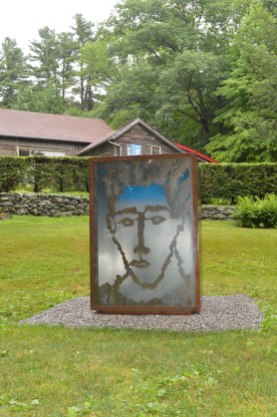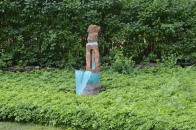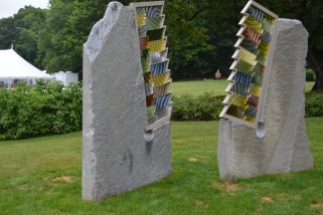Date Visited: July 16, 2016
Location: Chesterwood, 4 Williamsville Rd, Stockbridge, MA (413)298-3579
Hours: Open Saturday of Memorial Day Weekend to the Monday of Columbus Day Weekend. May 28 – October 10 of this year from 10am to 5pm daily. Self-guided tours only. Residence closed daily from 12:30pm – 2:00pm
Cost: Adults, $18.00; Seniors, $17.00; Grounds ONLY fee, $10.00; NTHP Members, Military & Children, 13-17, $9.00; Friends of Chesterwood & Children Under 13, Free
Parking: There is ample parking in the various parking areas for at least a couple hundred cars
Time To Allot For Visit: 1 hour to 2 hours (less if you don’t appreciate art)
Dog Friendly: No
Highlights: lots of art, statues, scenic trails
Nature Of Glass: Contemporary Sculpture

Named after one of America’s foremost sculptor, Chesterwood is home to the works of Daniel Chester French. French’s work can be found on multiple continents. His most prominent works include designing the Abraham Lincoln and the Minute Man statue in Concord, MA among many other works of art.
In addition to statues and replicas of French’s work, Chesterwood also shows off exhibits on its spacious grounds. The latest exhibit, on display until September 18, is a bit of a break from the traditional pieces of French. The Nature Of Glass shows a variety of unusual works of art for the entire family.
This blown gas display called Optic Lens Installation (2016) is by Richard Royal. Part of the Optic lens series, this art evolved from his fascination with water or being near water as well as lighthouses and the Fresnel lens. On the description plaque for this design, Royal said safety and security are recurring themes. he finds glass and light as instruments of safety to be inspiring and he finds the system of glass and light to be metaphor for simple concepts and a reminder that basic things in life are sometimes the most important and have the strongest impact.
Throughout the exhibition, I found the artists to have a such depth and insight into what may seem to be simple displays. This is a recurring theme throughout the displays. It does make sense that the artists would have a deeper meaning to their work. One does not put so much time and effort into a work of art without having some deep significance to their work and inspiration.
This sculpture by John Kiley is called Clear Cut (2016). Kiley made this 8 foot sculpture out of glass, steel and Douglas fir. According to the information on the sign next to the display, Kiley described his work as using circular openings to show interior divisions of space to alter their sense of space and light. Depending on your point of view, the overlapping circles can focus your attention in different ways. The Douglas fir is meant to connect the ground through a natural material to the sky using material engineered by humans, evoking a sense of history, place and reflection.
Martin Blank created Crystal Reveil (2012) from hot sculpted glass. The segments of the sculpture are curled and hollow so you can look through the sculpture and see a different form of negative space. The individual forms are very delicate and skin-like, similar to the madrone tree which is prevalent in the pacific Northwest.
Depending on where you stand and the time of day that you view Time Of Day – Blue Moment (2016), by Richard Jolley, looks different. As you can see by the photos above, you see different things from each angle. The work of art is of a veiled form of a human figure that changes color at specific times of the day. The passage of light through the small portal will shift the light transmission and wash the figure in a blue light referencing daily time sequencing and change. The intent, according to Jolley is to not only mark a specific, finite time of day but also to address the significance of the passage of time and awareness. He went on to say how it addresses in a deeper sense time and the effect it has on every aspect of our existence.
I did photograph Time of Day again later in the day after viewing the other sculptures about an hour later to see any changes in the work. Unfortunately, it was an overcast and misty day. So, since there was a lack of light, the changes in the art work were very minor. The photos are shown below
One In One (2014) by Thomas Scoon is a cast glass and granite sculpture. Just short of 5 feet (57 inches to be exact), the figures are meant to show people rising from the external landscape. He tried to choose rocks that evoked the feeling and gesture of human forms, specifically torsos and heads. The layering of kiln-cast glass and stone allows light to pass through the figures and embodies the spiritual and physical essence of human nature into the sculpture. He felt the combination of the materials expresses both the fragility and the enduring qualities and humanity.
Scoon continued with his granite and glass theme with Companion Series I-IV (2016). Similar to the One In One sculpture,this work shows human figures made of cast glass and granite. I suppose he didn’t want his other sculpture to feel lonely.
Earth/Sky (2016) by Tom Patti is one of the more unusual works at the exhibit. Patti wanted to show the ambiguous condition between the literal and the phenomenal. Patti felt the unique quality of the reflection combines the transparency of glass in his design. This combination results in an ambiguous sense of space that obscures any references to the physical solidity of the materials, revealing the natural essence of the environment.
This work of art, like many more in the exhibit, was not as provocative because of the lack of light on the day of my visit. If the sun had been out the shadows would have played off the work of art more dramatically.
One of the more unique works of art, Remember What (2016) by Marko Remec is 128 thirty two inch dome acrylic mirrors. Also made of aluminum, steel hardware and twine, Remec’s work is described as a “chess pattern gone awry.” The mirrors reflect 180 degrees of Chesterwood. The work is a reconfiguration of the installation Can’t Hear You that had been displayed at MASS MoCA in North Adams, MA.
Another piece of work that would have benefited from sunlight, Vitro Muralis (2016) by William Carlson is made of granite, metal and glass. The sculpture shares a common area of overlap. The edges have a visual noise as they collide into shared space. The transparent components are meant to offer a language of design as a text of spiral repetition and marks that are more musical than linguistic, according to Carlson.
Another design by William Carlson, Sine Nomine (Without A Name) (2014) is another sculpture made of metal and glass. The “x” in the middle of the sculpture is meant to reference missing identity. It has also been used as a mark for those who cannot sign their name or in equations in algebra as an unknown in the equation. Other interpretations include a reference to something that has been eliminated from a list. The historical use of the x also makes it a powerful graphic symbol universally understood. The exact meaning is not made clear in the plaque next to the sculpture.
Icebergs and Paraphernalia 117 (2007) was inspired by traveling through the Polar Regions, specifically a small stranded iceberg off the shore of Greenland that looked like a bird. Created by Peter Bremers, the work of art is made of kiln-formed glass cut and polished and outdoor glass. The almost marble structure pays tribute to the marble sculptures of the French.
Also made of kiln-formed glass cut and polished and outdoor glass, Movement II (2007) depicts a window moving forward. The concept of the work is that we perceive “reality” as a dynamic image that changes in time and as a result of the viewer’s change in perception as well as how we rewrite history as our understanding of the past transforms the present and vice versa.
Daniel Clayman’s North 41.47 West 71.70 Copper (2016) may just look like an ordinary rock but there’s much more to this boulder. The name coincides with the GPS coordinates where the boulder was found. Copper refers to the interior treatment of the piece. While on a jobsite excavation, Clayman observed large boulders being carted away to make room for a new landscape design. Clayman was struck with the idea of reformatting an ordinary boulder into a magical object. When the sun is out, the sun reflects off the copper boulder making it a highly detailed surface (I had to use a flash to gain the same effect).
Julia’s Garden (the pieces range from 2010 to 2016) includes pieces from Nancy Callan’s Orbs And Winkle’s signature series. The design consists of geometric forms (spheres and cones). Callan strived to create a sense of infinity complexity with lines that wrap and fold around the shapes. Each orb is like a world in itself. The shapes of the orbs are said to represent planets. The cones are meant to be like stocking caps – a reference to Rip Van Winkle – which gave the name Winkle to the pieces. The cones also add a vertical element that echoes the growth of plants and trees – straight towards the sun as in White Spiral Cone or gently unfurling as in Ivory Winkle.

Trigonal (2016) by Kait Rhoads was inspired by a trip Rhoads took to the Joshua Tree National Park in California after her the mother’s death. Rhoads was struck by the beauty in the contrast of the quartz seams running through the fields of granite rock in the landscape. Her search for healing and cleansing within a natural habitat largely untouched by man drew her to create the work of art. She placed the color of the desert sky onto the form of the quartz crystal in a wash of opaque white ranging to intense transparent blue.
There is another work of art that I somehow missed. Sidney Hutter’s Louie’s Electric Two (1976, revised in 2016) is sandblasted mirror glass design.
Dogs are not allowed at Chesterwood. But, I did find this friendly cat.
Connect with me on Facebook to view photos, videos and other posts not included in this blog































































July 14th, 2016 at 12:17 pm
Very interesting art and a beautiful kitty 😀
LikeLiked by 1 person
July 14th, 2016 at 1:07 pm
It was such a creative display! And yes, the resident kitty was beautiful as well! Thank you, Irene.
LikeLiked by 1 person
July 14th, 2016 at 4:25 pm
Very cool, love the art.
LikeLiked by 1 person
July 14th, 2016 at 4:37 pm
Yes, it’s pretty amazing! Thank you.
LikeLiked by 1 person
July 14th, 2016 at 9:20 pm
What a find! That art is fantastic.
LikeLiked by 2 people
July 14th, 2016 at 10:53 pm
Isn’t it? It was great because the pieces were set up along a trail so it was cool walking along the trail and waiting to see what you will see next.
LikeLike
July 15th, 2016 at 1:29 am
Reblogged this on By the Mighty Mumford and commented:
CATS SHOULD BE ALWAYS WELCOME IN MY BOOK! DOGS RUN AND JUMP AND BREAK THINGS! QUITE AN ARRAY—I LIKE THE COLORED GLOBES AMONG THE FERNS (LIKE A MODERN FAIRY VILLAGE) AND THE BIGGER GLASS SCULPTURES.
LikeLiked by 1 person
July 15th, 2016 at 2:08 am
Cats appreciate fine art more than dogs!
LikeLike
July 15th, 2016 at 2:34 am
SO TRUE! 😀
LikeLiked by 1 person
July 17th, 2016 at 4:39 pm
Looks like a very interesting place to visit.
LikeLiked by 2 people
July 17th, 2016 at 11:54 pm
It is! I especially like the explanations and interpretations of the art the artists gave. Thank you Heather!
LikeLiked by 1 person
July 31st, 2016 at 11:16 am
🌟🌟🌟
LikeLiked by 2 people
October 26th, 2016 at 6:05 pm
Great post! The round orbs are so pretty and love the pops of color they bring to the green landscape.
LikeLiked by 1 person
October 26th, 2016 at 7:49 pm
Thank you, Janell! It was overcast the day I went. I bet it looks even prettier when the sun is hitting it directly.
LikeLiked by 1 person